CT-based volumetric assessment of rotator cuff muscle in shoulder arthroplasty preoperative planning
- PMID: 34315280
- PMCID: PMC8329519
- DOI: 10.1302/2633-1462.27.BJO-2021-0081.R1
CT-based volumetric assessment of rotator cuff muscle in shoulder arthroplasty preoperative planning
Abstract
Aims: The aim of this study was to describe a quantitative 3D CT method to measure rotator cuff muscle volume, atrophy, and balance in healthy controls and in three pathological shoulder cohorts.
Methods: In all, 102 CT scans were included in the analysis: 46 healthy, 21 cuff tear arthropathy (CTA), 18 irreparable rotator cuff tear (IRCT), and 17 primary osteoarthritis (OA). The four rotator cuff muscles were manually segmented and their volume, including intramuscular fat, was calculated. The normalized volume (NV) of each muscle was calculated by dividing muscle volume to the patient's scapular bone volume. Muscle volume and percentage of muscle atrophy were compared between muscles and between cohorts.
Results: Rotator cuff muscle volume was significantly decreased in patients with OA, CTA, and IRCT compared to healthy patients (p < 0.0001). Atrophy was comparable for all muscles between CTA, IRCT, and OA patients, except for the supraspinatus, which was significantly more atrophied in CTA and IRCT (p = 0.002). In healthy shoulders, the anterior cuff represented 45% of the entire cuff, while the posterior cuff represented 40%. A similar partition between anterior and posterior cuff was also found in both CTA and IRCT patients. However, in OA patients, the relative volume of the anterior (42%) and posterior cuff (45%) were similar.
Conclusion: This study shows that rotator cuff muscle volume is significantly decreased in patients with OA, CTA, or IRCT compared to healthy patients, but that only minimal differences can be observed between the different pathological groups. This suggests that the influence of rotator cuff muscle volume and atrophy (including intramuscular fat) as an independent factor of outcome may be overestimated. Cite this article: Bone Jt Open 2021;2(7):552-561.
Keywords: 3D CT scan; atrophy; fatty infiltration; muscle volume; occupation ratio; rotator cuff muscle; shoulder arthroplasty; tangent sign; volumetric analysis.
Conflict of interest statement
Ramsay Générale de Santé, Hôpital Privé Jean Mermoz Lyon, France.
Figures

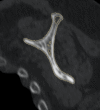
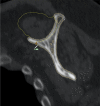
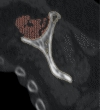
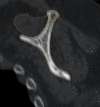
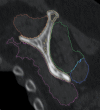
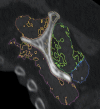
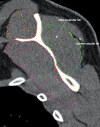
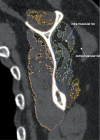
Similar articles
-
Three-dimensional muscle loss assessment: a novel computed tomography-based quantitative method to evaluate rotator cuff muscle fatty infiltration.J Shoulder Elbow Surg. 2022 Jan;31(1):165-174. doi: 10.1016/j.jse.2021.07.029. Epub 2021 Aug 31. J Shoulder Elbow Surg. 2022. PMID: 34478865
-
Does the Walch type B shoulder have a transverse force couple imbalance? A volumetric analysis of segmented rotator cuff muscles in osteoarthritic shoulders.J Shoulder Elbow Surg. 2021 Oct;30(10):2344-2354. doi: 10.1016/j.jse.2021.02.005. Epub 2021 Mar 3. J Shoulder Elbow Surg. 2021. PMID: 33675976
-
A semi-automated quantitative CT method for measuring rotator cuff muscle degeneration in shoulders with primary osteoarthritis.Orthop Traumatol Surg Res. 2017 Apr;103(2):151-157. doi: 10.1016/j.otsr.2016.12.006. Epub 2017 Jan 4. Orthop Traumatol Surg Res. 2017. PMID: 28064003
-
[Reversed total shoulder arthroplasty in rotator cuff defect arthropathy].Orthopade. 2018 May;47(5):390-397. doi: 10.1007/s00132-018-3543-6. Orthopade. 2018. PMID: 29516107 Review. German.
-
The pathogenesis and management of cuff tear arthropathy.J Shoulder Elbow Surg. 2018 Dec;27(12):2271-2283. doi: 10.1016/j.jse.2018.07.020. Epub 2018 Sep 26. J Shoulder Elbow Surg. 2018. PMID: 30268586 Review.
Cited by
-
Automatic MRI-based rotator cuff muscle segmentation using U-Nets.Skeletal Radiol. 2024 Mar;53(3):537-545. doi: 10.1007/s00256-023-04447-9. Epub 2023 Sep 12. Skeletal Radiol. 2024. PMID: 37698626
-
Objective analysis of partial three-dimensional rotator cuff muscle volume and fat infiltration across ages and sex from clinical MRI scans.Sci Rep. 2023 Sep 1;13(1):14345. doi: 10.1038/s41598-023-41599-z. Sci Rep. 2023. PMID: 37658220 Free PMC article.
-
Automated 3D segmentation of rotator cuff muscle and fat from longitudinal CT for shoulder arthroplasty evaluation.Skeletal Radiol. 2025 Aug 9:10.1007/s00256-025-04991-6. doi: 10.1007/s00256-025-04991-6. Online ahead of print. Skeletal Radiol. 2025. PMID: 40782188 Free PMC article.
-
Individuals with rotator cuff tears unsuccessfully treated with exercise therapy have less inferiorly oriented net muscle forces during scapular plane abduction.J Biomech. 2024 Jan;162:111859. doi: 10.1016/j.jbiomech.2023.111859. Epub 2023 Nov 8. J Biomech. 2024. PMID: 37989027 Free PMC article.
-
The present and future of preoperative planning.JSES Int. 2024 Sep 19;9(3):954-959. doi: 10.1016/j.jseint.2024.09.002. eCollection 2025 May. JSES Int. 2024. PMID: 40486779 Free PMC article.
References
-
- Iannotti JP, Walker K, Rodriguez E, Patterson TE, Jun BJ, Ricchetti ET. Accuracy of 3-dimensional planning, implant templating, and patient-specific instrumentation in anatomic total shoulder arthroplasty. J Bone Joint Surg Am. 2019;101-A(5):446–457. - PubMed
-
- Nyffeler RW, Werner CML, Gerber C. Biomechanical relevance of glenoid component positioning in the reverse Delta III total shoulder prosthesis. J Shoulder Elbow Surg. 2005;14(5):524–528. - PubMed
-
- Yongpravat C, Kim HM, Gardner TR, Bigliani LU, Levine WN, Ahmad CS. Glenoid implant orientation and cement failure in total shoulder arthroplasty: A finite element analysis. J Shoulder Elbow Surg. 2013;22(7):940–947. - PubMed
-
- Gladstone JN, Bishop JY, IK L, Flatow EL. Fatty infiltration and atrophy of the rotator cuff do not improve after rotator cuff repair and correlate with poor functional outcome. Am J Sports Med. 2007;35. - PubMed
-
- Goutallier D, Postel JM, Bernageau J, Lavau L, Voisin MC. Fatty muscle degeneration in cuff ruptures. Pre- and postoperative evaluation by CT scan. Clin Orthop Relat Res. 1994;304:78–83. - PubMed

